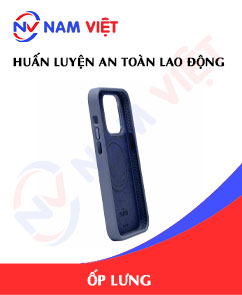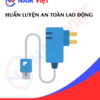Occupational Safety Training for Phone Case Manufacturing
99,000 ₫
Note: The above price is calculated per person and may vary depending on the number of trainees participating in the course and market fluctuations. For more accurate pricing support, please refer to the pricing list or contact our consulting staff directly.
Occupational safety is an important issue in phone case manufacturing plants and needs to be addressed promptly to ensure the health and safety of workers and enhance the reputation of businesses. The Occupational Safety Training is one of the effective solutions to raise awareness on how to prevent occupational accidents for workers involved in phone case production.
Table of Contents
Toggle1. Overview of Phone Cases
a. What is a Phone Case?
Phone cases (also known as smartphone/tablet cases) are protective accessories used to cover mobile devices such as smartphones or tablets. The main function of a phone case is to protect the device from impacts, scratches, and other damages during daily use. Additionally, phone cases may have other features such as dust resistance, water resistance (in some cases), and aesthetic enhancement with diverse designs and patterns.

b. Machinery for Phone Case Production
- Plastic Injection Molding Machines:
- Used to mold plastics (such as polycarbonate, polyurethane) into phone case parts according to molds.
- Laser Cutting Machines:
- Used to cut plastic sheets into precise shapes and sizes for different types of phones or tablets.
- UV Printing Machines:
- Used to print images, patterns, or logos on the surface of phone cases using UV printing technology, allowing very fine and sharp details.
- Heat Press Machines:
- Used to apply protective layers, such as silicone coatings, onto phone cases by using heat and pressure.
- CNC Machining Centers:
- Used to process aluminum, steel, or other metal materials to create durable and aesthetic phone case frames.

c. Phone Case Manufacturers in Vietnam
- Spigen: Spigen is one of the leading brands in protective phone accessories, including shockproof cases and other accessories.
- OtterBox: OtterBox specializes in producing strong protective cases, especially the Defender Series known for high shock resistance.
- Case-Mate: This brand is famous for stylish and luxurious phone cases, offering a wide range from basic to premium designs.
- Tech21: Tech21 is a brand specializing in shockproof cases, using proprietary technology to protect phones from strong impacts.
- Spigen: Spigen is one of the top phone accessory brands, known for durable products and modern designs.
- RhinoShield: This brand is known for ultra-durable and ultra-thin cases that provide good protection while keeping the device slim.
- UAG (Urban Armor Gear): UAG produces highly impact-resistant and durable cases designed for use in harsh environments.

d. Specific Jobs in a Phone Case Production Factory
Group 1
- Executive directors, deputy executive directors, department heads in phone case production factories.
Group 2
- Safety officers: managing safety in the factory, designing safety procedures, supervising and urging employees to comply with safe working procedures.
Group 3
- Tooling: This involves creating molds made of metal or other materials to cast or mold plastic parts into desired shapes and sizes of phone cases.
- Plastic Production: Using injection molding machines to cast plastic parts into phone case components based on prepared molds.
- Cutting and Processing: Using laser cutters, CNC machines, and other equipment to cut, process, and finish plastic parts into final products. This may include shaping, drilling holes for ports, and smoothing surfaces.
- Printing and Finishing: Using UV printers to print images, patterns, or logos on phone case surfaces. Then using heat press machines to apply protective layers or other finishes such as glossy coating or scratch resistance.
- Quality Control: Conducting quality inspections to ensure products meet standards and technical requirements such as durability, shock resistance, and device protection.
- Packing and Boxing: After quality checks, products are packed, boxed, and prepared for shipment to customers or distributors.
Group 4
- Office work, service, sales, marketing.
- Production management, quality management, human resource management, material management, financial and accounting management.
- Research and development of new products, designing product packaging and styles.
2. Overview of Occupational Safety Training for Phone Case Production
Within this article, we focus on issues related to Group 3 because Group 3 is the group directly involved in the production process and faces the highest occupational safety risks. For more on other groups, see here.
a. What is Group 3 Occupational Safety Training?
- Group 3 occupational safety training consists of sessions to equip workers with awareness on preventing workplace accidents.
- The safety training course helps workers recognize and avoid hazards, reducing risks of occupational accidents while working.
REGISTER FOR OCCUPATIONAL SAFETY TRAINING SERVICE
b. Training Duration
Initial safety training duration
- Total training time is at least 24 hours, including test time.
- 8 hours of theory on safety and occupational hygiene policies and legal system
- 8 hours of theory on basic occupational safety and hygiene knowledge
- 4 hours of theory on specialized training content
- 2 hours of practical training on specialized content
- 2 hours for final theoretical test at course end
The safety training center will arrange the time into multiple sessions depending on scheduling for workers. Usually, there are 6 training sessions over 3 days, provided the company arranges continuous learning time.
Periodic safety training duration
- Before the occupational safety card expires, workers who want to renew must attend periodic occupational safety training, with the periodic training duration being at least 50% of the initial training duration.
Explanation: The total periodic occupational safety training time is at least 12 hours, including test time. After completing the periodic training and passing the test, workers will be reissued or extended their occupational safety card.
c. Training Content
| No. | TRAINING CONTENT | TRAINING DURATION (HOURS) | |||
| Total | Including | ||||
| Theory | Practice | Test | |||
| I | System of policies, laws on occupational safety and hygiene | 8 | 8 | 0 | 0 |
| 1 | Overview of legal documents system on occupational safety and hygiene. | 6 | 6 | ||
| 2 | Standards and technical regulations on occupational safety and hygiene. | 1 | 1 | ||
| 3 | Specific regulations by state management agencies on safety and hygiene when constructing, expanding, or renovating facilities for manufacturing, using, storing, preserving, and inspecting machines, equipment, materials, and substances with strict occupational safety and hygiene requirements. | 1 | 1 | ||
| II | Basic knowledge of occupational safety and hygiene | 8 | 8 | 0 | 0 |
| 1 | Basic knowledge about hazards and harmful factors at the workplace. | 4 | 4 | ||
| 2 | Methods to improve working conditions. | 1 | 1 | ||
| 3 | Safety culture in production and business. | 1 | 1 | ||
| 4 | Rights and obligations of employers and employees; policies and regimes on occupational safety and hygiene for workers; functions and duties of safety networks and safety officers. | 1 | 1 | ||
| 5 | Safety and hygiene regulations, safety signs, instructions, use of safety equipment, personal protective equipment; accident first aid skills, prevention of occupational diseases. | 1 | 1 | ||
| III | Specialized training content | 6 | 4 | 2 | 0 |
| Comprehensive knowledge of machines, equipment, hazardous substances; analysis, evaluation, risk management of occupational safety and hygiene; safe working procedures with machines, equipment, and substances with strict safety requirements. | 6 | 4 | 2 | ||
| IV | Final safety training test at course completion | 2 | 2 | 0 | 0 |
| Total | 24 | 22 | 2 | ||
See more training contents of the 6 groups
d. Occupational Safety Card
After completing the occupational safety training course and passing the test, workers will be issued the occupational safety card (commonly called the occupational safety certificate for Group 3).
This card clearly shows information such as name, date of birth, specific job and working environment, as well as training duration, red stamp, and signature confirming course completion.
According to regulations on card issuance stated in Clause 2 of Article 24 Decree 44/2016/ND-CP, there are two cases:
- If the employer and employee have a labor contract, the employer must sign, stamp, and countersign the safety card for Group 3 employees after they complete training at the occupational safety training unit and pass the test.
- If the worker is freelance, seasonal, or without a labor contract, the training unit must sign, stamp, and countersign the safety card after the worker completes training and passes the test.

3. Identifying Hazards Affecting Workers During Phone Case Production
When producing phone cases, there are several potential hazards that may affect workers. Below are some key points to recognize and address in the working environment:
- Risk of impact and injury: Due to the nature of the production process, there is a high risk of collisions, falls, and possible accidents. This is especially true for tasks involving machinery, such as cutting and machining, where fingers and hands may get caught or injured.
- Chemical hazards: The use of chemicals in production such as solvents, adhesives, or surface coatings can pose serious health risks to workers if not handled properly or if safety measures are lacking.
- Health risks from dust and fumes: Processes like cutting, machining, and plastic molding can generate dust and fumes, causing respiratory and health issues for workers if there is no effective ventilation and exhaust system.
- Risks related to temperature and voltage: Production machinery can generate high temperatures and high voltage, creating risks of burns, electric shocks, and other serious accidents if proper safety measures are not in place to protect workers.
- Ergonomic risks: Prolonged work in uncomfortable postures may cause back pain, neck pain, and other musculoskeletal problems.
To minimize these hazards, phone case manufacturing factories need to implement labor protection and safety measures such as training employees on occupational safety, providing personal protective equipment, improving work processes, and using safety devices like dust extraction systems, chemical management, and temperature control.

4. Safety Measures When Participating in Phone Case Production
- Occupational safety training: Training employees on potential hazards, accident prevention measures, and how to use personal protective equipment (PPE) is crucial. Ensure all staff know how to safely operate machinery, equipment, and handle chemicals.
- Use of personal protective equipment (PPE): Provide and require the full use of PPE such as safety goggles, masks, gloves, hand protection, and safety shoes to protect skin, eyes, and respiratory systems from chemical and dust hazards.
- Chemical control: Use and store chemicals according to safety regulations, including providing detailed information about their properties and safe handling. Ensure no direct skin contact or inhalation of toxic gases.
- Dust and fume management: Provide effective dust extraction systems to prevent dust accumulation in the work environment. Ensure cleaning and maintenance procedures keep the workplace clean and safe.
- Temperature and voltage monitoring: Control machine temperatures to avoid burns and ensure electrical safety when working with high-voltage equipment.
- Use of safety equipment: Ensure machinery and equipment are regularly maintained to guarantee safe and effective operation. Limit the use of damaged or unsafe equipment.
- Ergonomic management: Provide support tools to ensure workers maintain comfortable postures, reducing risks of back pain and musculoskeletal injuries.
- Periodically conduct occupational environment monitoring in factories to collect and analyze harmful factors affecting workers, thereby adjusting to reduce hazards and prevent occupational diseases.
5. Benefits of Occupational Safety Training for Phone Case Production
An Toàn Nam Việt provides your business with the following great benefits after completing occupational safety training courses as regulated by Decree 44/2016/ND-CP on Occupational Safety and Hygiene for companies and enterprises.
- Workers can recognize potential risks of occupational accidents and take preventive measures to avoid accidents.
- Your business can establish risk prevention measures during production, operation, and maintenance processes.
- Reduce costs related to potential safety incidents during labor.
- Continuous production without interruption helps increase labor productivity and product quality.
- Comply with labor safety laws and avoid legal risks.
- Create reputation and professionalism in all aspects, thereby enhancing your brand.
Nam Việt’s training courses are solutions to prevent external risk factors that could cause injuries or more severe consequences like fatalities.
REGISTER FOR OCCUPATIONAL SAFETY TRAINING SERVICE
6. Customer Feedback After Completing Phone Case Production Safety Training
An Toàn Nam Việt has many years of experience partnering with various enterprises in Vietnam, especially in the southern provinces. This responsibility is invaluable to Nam Việt, and therefore our Occupational Safety Training is increasingly professional. The motivation for Nam Việt’s growth comes from positive feedback and constructive suggestions from businesses we have served. Below are testimonials from our partners.
Bắc Nam E&C Investment and Construction Joint Stock Company
“My first time using An Toàn Nam Việt’s service, I was very surprised by the 24/7 enthusiastic support from the consulting team. Organizing classes was quick and convenient for our company, thank you very much!”
Hoa Đất Construction and Trading Joint Stock Company
“Nam Việt’s service has greatly helped us simplify occupational safety and complete safety documentation for our working processes. The consulting team is enthusiastic and timely in addressing our questions. 5 stars for Nam Việt.”
See more customer interview sessions after using An Toàn Nam Việt’s services
7. An Toàn Nam Việt’s Occupational Safety Training Capability
An Toàn Nam Việt is a reputable and quality occupational safety training center in Vietnam today. We conduct continuous safety training sessions at factories, production plants, or construction sites nationwide (all 63 provinces of Vietnam).
REGISTER FOR OCCUPATIONAL SAFETY TRAINING SERVICE
Occupational Safety Training License
- An Toàn Nam Việt has been inspected and certified by the Department of Safety under the Ministry of Labor – Invalids and Social Affairs, confirming our eligibility to operate occupational safety and hygiene training. This further strengthens our capability in occupational safety training.

Training Materials and Lectures
- Before being used in occupational safety training courses, training materials are reviewed and approved to ensure accuracy and effectiveness.
- Our instructors follow teaching methods standardized by An Toàn Nam Việt, developed by experts in occupational safety and hygiene training to maximize knowledge absorption by trainees.
Facilities
- Controlling environmental factors in training rooms improves teaching efficiency and learners’ knowledge absorption.
- Our training facilities offer spacious classrooms meeting standards on area, lighting, training equipment, etc.
8. Nationwide Reputable and Quality Safety Training Center
At An Toàn Nam Việt, we prioritize occupational safety training with utmost dedication. For us, imparting self-protection knowledge to workers equips them with safety on their livelihood journey, contributing to nation-building.
To ensure effective training, we carefully prepare every detail, from tools and teaching equipment to curricula, materials, sound, and lighting.
Our occupational safety instructors are experts with many years of experience. They have even conducted research on identifying hazards in various industries and how to prevent them.
Our lectures are practical and conveyed in an engaging, easy-to-understand way for workers. These factors help learners stay comfortable during study and effectively absorb our lessons. Naturally, the content aligns strictly with Decree 44/2016/ND-CP.
Thus, trainees learn many hazard prevention methods and how to protect themselves, applying them appropriately in real work situations.
Our training center proudly offers reputable, professional occupational safety training services with the following advantages:
- Competitive training costs while maintaining quality.
- Flexible training schedules aligned with company production needs.
- Fast and lawful procedures for issuing occupational safety training certificates.
- Experienced instructors with many years in the field.
- Classrooms controlled for environmental factors to enhance teaching efficiency and learner absorption.
- Courses tailored to occupational safety tasks at enterprises.
- An Toàn Nam Việt works diligently and professionally to support customers accurately and promptly.

9. Additional Reference Materials for Phone Case Production Safety Training
- Occupational Safety Materials for Phone Case Production
- Occupational Safety Training Materials Set
- Occupational Safety Training Test Set
- Occupational Safety Training Curriculum for Phone Case Production (smartphone/tablet cases)
- Occupational Safety Multiple-Choice Test for Phone Case Production (smartphone/tablet cases)
No comments yet















Review Occupational Safety Training for Phone Case Manufacturing
There are no reviews yet.